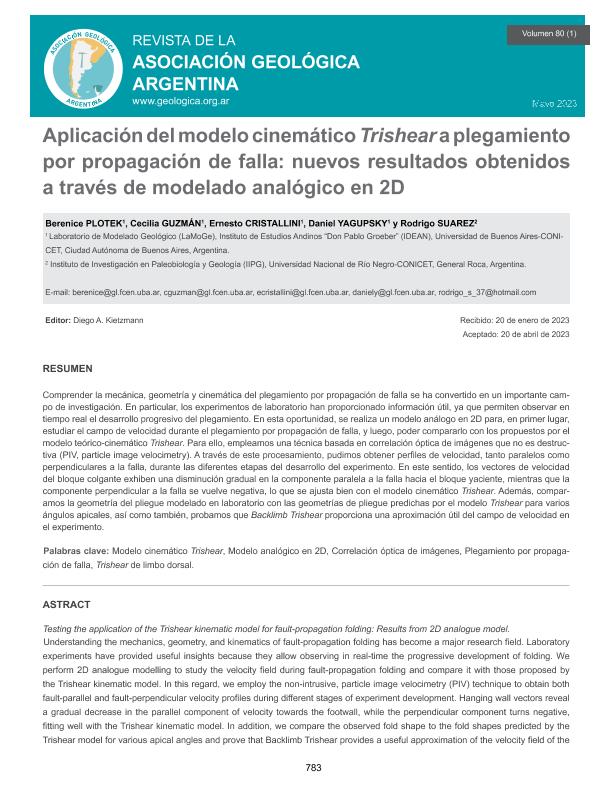Artículo
Comprender la mecánica, geometría y cinemática del plegamiento por propagación de falla se ha convertido en un importante cam-po de investigación. En particular, los experimentos de laboratorio han proporcionado información útil, ya que permiten observar en tiempo real el desarrollo progresivo del plegamiento. En esta oportunidad, se realiza un modelo análogo en 2D para, en primer lugar, estudiar el campo de velocidad durante el plegamiento por propagación de falla, y luego, poder compararlo con los propuestos por el modelo teórico-cinemático Trishear. Para ello, empleamos una técnica basada en correlación óptica de imágenes que no es destruc-tiva (PIV, particle image velocimetry). A través de este procesamiento, pudimos obtener perfiles de velocidad, tanto paralelos como perpendiculares a la falla, durante las diferentes etapas del desarrollo del experimento. En este sentido, los vectores de velocidad del bloque colgante exhiben una disminución gradual en la componente paralela a la falla hacia el bloque yaciente, mientras que la componente perpendicular a la falla se vuelve negativa, lo que se ajusta bien con el modelo cinemático Trishear. Además, compar-amos la geometría del pliegue modelado en laboratorio con las geometrías de pliegue predichas por el modelo Trishear para varios ángulos apicales, así como también, probamos que Backlimb Trishear proporciona una aproximación útil del campo de velocidad en el experimento. Understanding the mechanics, geometry, and kinematics of fault-propagation folding has become a major research field. Laboratory experiments have provided useful insights because they allow observing in real-time the progressive development of folding. We perform 2D analogue modelling to study the velocity field during fault-propagation folding and compare it with those proposed by the Trishear kinematic model. In this regard, we employ the non-intrusive, particle image velocimetry (PIV) technique to obtain both fault-parallel and fault-perpendicular velocity profiles during different stages of experiment development. Hanging wall vectors reveal a gradual decrease in the parallel component of velocity towards the footwall, while the perpendicular component turns negative, fitting well with the Trishear kinematic model. In addition, we compare the observed fold shape to the fold shapes predicted by the Trishear model for various apical angles and prove that Backlimb Trishear provides a useful approximation of the velocity field of the experiment. Although some researchers have investigated the kinematic field of fault-propagation folds using numerical models, fewer studies have addressed this issue using physical models. The present research explores the application of the Trishear method to fault-propagation folds based on analogue simulations.
Aplicación del modelo cinemático Trishear a plegamiento por propagación de falla: nuevos resultados obtenidos a través de modelado analógico en 2D
Título:
Testing the application of the Trishear kinematic model for fault-propagation folding: Results from 2D analogue model
Plotek, Berenice Lia ; Guzman, Cecilia Griselda
; Guzman, Cecilia Griselda ; Cristallini, Ernesto Osvaldo
; Cristallini, Ernesto Osvaldo ; Yagupsky, Daniel Leonardo
; Yagupsky, Daniel Leonardo ; Suárez, Rodrigo Javier
; Suárez, Rodrigo Javier
 ; Guzman, Cecilia Griselda
; Guzman, Cecilia Griselda ; Cristallini, Ernesto Osvaldo
; Cristallini, Ernesto Osvaldo ; Yagupsky, Daniel Leonardo
; Yagupsky, Daniel Leonardo ; Suárez, Rodrigo Javier
; Suárez, Rodrigo Javier
Fecha de publicación:
04/2023
Editorial:
Asociación Geológica Argentina
Revista:
Revista de la Asociación Geológica Argentina
ISSN:
0004-4822
e-ISSN:
1851-8249
Idioma:
Español
Tipo de recurso:
Artículo publicado
Clasificación temática:
Resumen
Archivos asociados
Licencia
Identificadores
Colecciones
Articulos(IDEAN)
Articulos de INSTITUTO DE ESTUDIOS ANDINOS "DON PABLO GROEBER"
Articulos de INSTITUTO DE ESTUDIOS ANDINOS "DON PABLO GROEBER"
Articulos(IIPG)
Articulos de INSTITUTO DE INVESTIGACION EN PALEOBIOLOGIA Y GEOLOGIA
Articulos de INSTITUTO DE INVESTIGACION EN PALEOBIOLOGIA Y GEOLOGIA
Citación
Plotek, Berenice Lia; Guzman, Cecilia Griselda; Cristallini, Ernesto Osvaldo; Yagupsky, Daniel Leonardo; Suárez, Rodrigo Javier; Aplicación del modelo cinemático Trishear a plegamiento por propagación de falla: nuevos resultados obtenidos a través de modelado analógico en 2D; Asociación Geológica Argentina; Revista de la Asociación Geológica Argentina; 80; 4-2023; 98-114
Compartir



